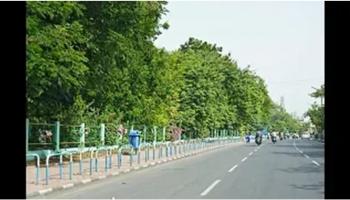Water Management
The indigenous struggle- A look at three South American films on water rights
Posted on 31 Aug, 2010 02:51 PMThis past weekend was the only international film festival on water, worldwide—Voices from the Water, held in Bangalore in several different locations. Working for a water NGO, I made my schedule free to catch up on some of these movies, to understand what the current issues are and what the film circle is capturing through their lens that we don’t necessarily see from our biased eyes.
Dr G.D. Agrawal s tapasya - Achieved the desired result
Posted on 30 Aug, 2010 12:47 PMDr G.D. Agrawal’s tapasya, his third fast-unto-death, has finally achieved the desired result. Since 2008, Dr Agrawal has been trying to persuade the Government of Uttarakhand and the Government of India that R. (Bhagirathi) Ganga must be allowed to flow in its natural state in the uppermost reach between Gangotri and Uttarkashi. The two governments had plans to construct three new large hydropower projects in this stretch. Dr Agrawal’s fasts have led to the scrapping of all the three projects.
Rainwater harvesting initiatives in Bangalore - A paper by KSCST
Posted on 29 Aug, 2010 12:10 AMThis paper by AR Shivakumar of the Karnataka State Council for Science and Technology (KSCST), presented at a national seminar organised by ISRO at NIAS Bangalore in 2010, begins by highlighting the increasing problem of scarcity of water that the city of Bangalore has been experiencing in recent years and suggests a required plan of action for a sustainable water supply system in the city.
Movie reviews from 'Voices from the Waters 2010' film festival held in Bangalore
Posted on 28 Aug, 2010 08:58 AM
Reviews of some of the movies screened -
“Be water, My friend”
This UNESCO funded film, “Be water, My friend” tracks the research of Professor Gordon Lightgoot, an expert on ancient water monuments as he tries to understand and rectify the alarming drying up of Karez’s in northern Iragi region of Kurdistan.
Community organisation in groundwater management – A presentation by ACWADAM
Posted on 27 Aug, 2010 04:01 PM This presentation by ACWADAM on community organization in groundwater management deals with the processes involved in people’s mobilization and participation. The requisites of groundwater management include: resource enhancement, demand management, equitable distribution, institutional mechanism and controlling of free riding. It deals with groundwater management at a local scale when compared to aquifer management.
This presentation by ACWADAM on community organization in groundwater management deals with the processes involved in people’s mobilization and participation. The requisites of groundwater management include: resource enhancement, demand management, equitable distribution, institutional mechanism and controlling of free riding. It deals with groundwater management at a local scale when compared to aquifer management.
Aquifer management involves:
- Identification of aquifer on the basis of geology;
- Identification of recharge and discharge areas;
- Assessment of aquifer capacity and yield through aquifer mapping;
- Protection of recharge area and increasing the groundwater level through artificial recharge in recharge area (based on the geology);
- Treating groundwater as a common property resource;
- Encouraging community use of groundwater and restricting individual use;
- Putting in place an institutional mechanism and legal back up for community groundwater management;
- Awareness generation regarding groundwater and science of hydrogeology.
Hydraulic conductivity: The ability of the rock material to allow the flow of groundwater – A presentation by ACWADAM
Posted on 27 Aug, 2010 08:10 AM This presentation by ACWADAM on hydraulic conductivity deals with the hydrologic properties of rocks that signify the status of a rock as a good or poor aquifer. The status of a rock with regard to groundwater occurrence and movement is decided by its porosity (specific yield, more practically) and its hydraulic conductivity. These properties decide whether a rock can store and transmit groundwater.
This presentation by ACWADAM on hydraulic conductivity deals with the hydrologic properties of rocks that signify the status of a rock as a good or poor aquifer. The status of a rock with regard to groundwater occurrence and movement is decided by its porosity (specific yield, more practically) and its hydraulic conductivity. These properties decide whether a rock can store and transmit groundwater.
Hydraulic conductivity is also commonly called as permeability of the rock or rock material and is its ability to allow the flow of groundwater through it. A rock with good hydraulic conductivity allows groundwater to easily flow through it.
The presentation describes Darcy’s Apparatus, which comprises of a glass cylinder filled with porous sand. The glass cylinder with the sand bed had an inlet for inflow of water and an outlet for outflow of water. Two vertical glass tubes (manometers) are fitted in the sand tube placed at a fixed distance from each other to measure the respective levels (hydraulic heads).
Environmental flows in river basins: A case study of river Bhadra - Current Science
Posted on 26 Aug, 2010 12:50 PMThe quantity and seasonality of water flow in a river may greatly change from its normal condition between a major storage and downstream, thus paving the way for drastic changes in the riverine ecosystem. ‘Environmental flow’ refers to the amount of water considered sufficient for protecting the structure and function of an ecosystem and its dependent species.
The paper goes on to describe the case of river Bhadra, which is the site of a dam that has significantly altered the natural flow of the river and describes the study that aimed at conducting the environment flow analysis of the river.
Water Jobs via DevNetJobsIndia.org dated August 25, 2010
Posted on 25 Aug, 2010 04:13 PMContent Courtesy: DevNetJobsIndia
- Technical Officer
WaterAid India
Location: Bhubaneshwar
Last Date: September 5, 2010
Water for All - An educational booklet by Utthan
Posted on 25 Aug, 2010 10:32 AMThis document is an educational booklet on water management, published by Utthan, which works towards empowering women's groups to seek clean and adequate quality of water for all.
The booklet provides background information on water as an important natural resource and the importance of protecting and maintaining the quality and quantity of this natural resource.
The details have been explained in a manner that is simple and understandable and include illustrations that are self explanatory and easy to follow.
The booklet is divided into the following sections:
Water quality status of historical Gundolav lake - Kishangarh - South Asian Journal of Tourism and Heritage
Posted on 25 Aug, 2010 09:44 AMThis paper published in the South Asian Journal of Tourism and Heritage describes the water quality status of Gundolav Lake in Rajasthan, which was once used for drinking water as well as for recreational activities under the tutelage of the princely state of Kishangarh. This has now become a site of wastewater disposal and facing a critical threat for its sustenance.
Recent years have led to an increasing awareness of the importance of water bodies and the need for conservation of water bodies, especially freshwater wetlands. The Ramsar Convention (2002) identifies wetlands as the starting point for integrated water management strategies. This is because they are the source of fresh water, maintain the health of the water course and water bodies, have the capacity to supply water to meet the human needs and are a key to future water security.







